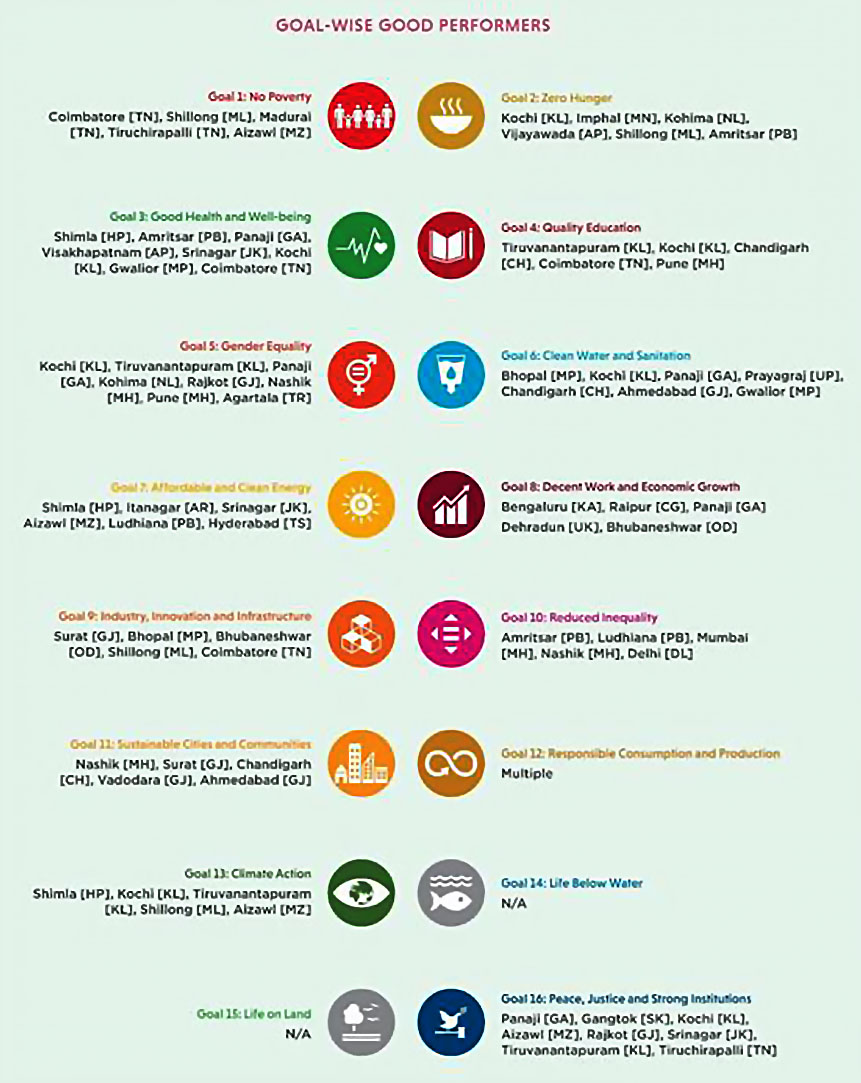Governance
SDG Urban Index: NITI Aayog
- 24 Nov 2021
- 4 min read
Why in News
Recently, NITI Aayog under the Indo-German Cooperation released the inaugural Sustainable Development Goals (SDGs) Urban Index and Dashboard 2021–22.
- Earlier in June 2021, the third edition of the Sustainable Development Goals (SDG) India Index and Dashboard 2020–21 was released by NITI Aayog.
Key Points
- About:
- The index and dashboard are a result of the NITI Aayog-Germany's International Cooperation Agency (GIZ) and BMZ collaboration focused on driving SDG localization in our cities, under the umbrella of Indo-German Development Cooperation.
- It ranks 56 urban areas on 77 SDG indicators across 46 targets of the SDG framework.
- It will further strengthen SDG localization and institute robust SDG monitoring at the city level.
- Ranking Scale:
- The urban areas are ranked on a scale of 0-100.
- A score of 100 implies that the urban area has achieved the targets set for 2030; a score of 0 implies that it is the farthest from achieving the targets among the selected urban areas.
- Overall or composite urban area scores are then generated from the Goal-wise scores to measure aggregate performance of the urban area.
- Urban areas have been classified as below based on their composite score:
- Aspirant: 0–49
- Performer: 50–64
- Front-Runner: 65–99
- Achiever: 100
- Performance of the States:
- Top Performers:
- Shimla, Coimbatore, Chandigarh, Thiruvananthapuram and Kochi.
- Worst Performers:
- Dhanbad, Meerut, Itanagar, Guwahati and Patna.
- Top Performers:
- Significance Of the Index:
- Cities are fast becoming engines of growth. The SDG Urban index and dashboard will go a long way in instituting a robust SDG monitoring system in our cities, and is a milestone step in our SDG localisation journey.
- The Niti Aayog is of the view that this transformative change is quite essential, given the increasing prominence of our cities and urban areas in charting the future of development in India.
- It highlights the strengths and gaps of Urban Local Body (ULB) level data, monitoring, and reporting systems.
- Cities are fast becoming engines of growth. The SDG Urban index and dashboard will go a long way in instituting a robust SDG monitoring system in our cities, and is a milestone step in our SDG localisation journey.
Indo-German Development Cooperation
- Background:
- The year 2008 marked 50 years of Indo-German development cooperation. Begun in the 1950s, development cooperation with India grew so rapidly that in a short time it became the largest recipient of German development assistance.
- The construction of the Rourkela Steel Plant in Orissa was a hallmark of this intensive cooperation in the early 1960s.
- Later, both countries set up one of India's premiere educational institutions - the Indian Institute of Technology in Madras.
- In the 1990’s, development cooperation dealt with the issues of poverty reduction and social infrastructure.
- About:
- Indo-German development cooperation is a solid pillar of the Indo-German strategic partnership.
- Both countries are equally committed to achieving the Millennium Development Goals (MDGs); further, they want to tackle global challenges in the fields of climate and environment.
- It is well integrated in the foreign policy framework of relations between India and Germany.
- India is viewed by Germany as one of the Global Development Partners that have a key role to play in solving global development issues.
- Programme Focus:
- Today, the Indo-German development cooperation programme focuses on the following mutually agreed priority areas:
- Energy
- Environment and Management of Natural Resources
- Sustainable Urban Development
- Today, the Indo-German development cooperation programme focuses on the following mutually agreed priority areas:
Source: PIB





